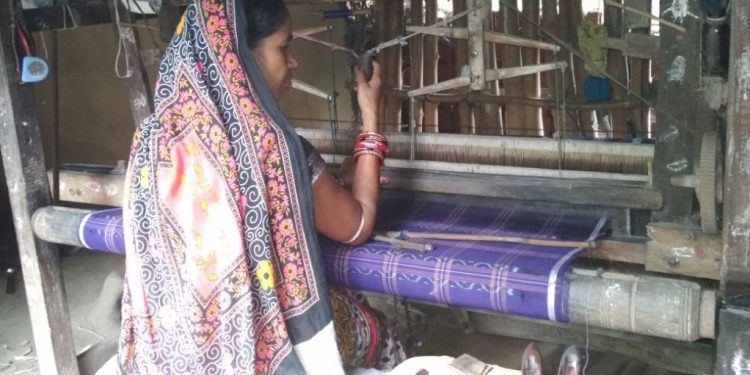Kendrapara: Lack of government sponsorship, publicity and marketing facilities along with the use of modern sewing machines and quality threads has dealt a body blow to the traditional handloom sector in this district, as per a report. The impact can be gauged from the fact that over 70 per cent of the handloom units in the district have been shut down.
Moreover, over 7,000 weavers have lost their jobs to modernisation sweeping the textile industry. They have been managing their profession somehow but the Covid pandemic dealt a heavy blow to their businesses. They have stopped preparing clothes like dhoti napkins (gamchha) and sarees which had been their bread and butter for decades.
Moreover, several handloom weavers’ cooperative societies which had been marketing their products and working to safeguard their interests have now become a thing of the past after becoming defunct. Tapan Sahu, a weaver of Kushiapal village on the outskirts of Kendrapara town, said that many looms have fallen silent as several weavers are now not keen on weaving sarees, lungis, dhotis, and towels. The increasing cost of raw materials has robbed the sheen off their businesses. He said that over 10,000 weavers of Kushiapal, Dihasahi, Haripur, Korua, Kutaranga, Keutagada, and other villages depended on weaving clothes for their livelihood. Handwoven napkins, dhotis, and shawls produced were in great demand even in foreign countries. Weaving clothes in the loom became part of the curriculum and a school was established for the purpose during the freedom struggle launched by Mahatma Gandhi.
However, despite a demand for handloom products, many units are on the verge of closure while others have shut down due to lack of government sponsorship. Another weaver Narayan Bhadra of Korua village said that weaving is the second form of livelihood for many after agriculture. Over 3,000 people are still engaged in weaving textile products. Their business was completely shut for a period of two years during Covid pandemic while some have returned to business after lifting of the restrictions.
However, the weavers are losing their faith in this business after being troubled by a series of problems. The youths are no more interested in the age-old occupation and are migrating outside in search of other jobs. Harekrushna Das, president of the Kushiapal handloom weavers’ cooperative society, said that the demand for handloom products is still high but lack of marketing facilities is troubling them. Another weaver Ajay Kumar Behera said the increasing cost of raw materials and lack of its proper availability have hit them hard.
Moreover, the restrictions on the use of chemical colours have got in the way of manufacturing impressive handloom products. Things have come to such a pass that the weavers now fail to recover the production cost of a handloom product when sold. This apart, handloom products do not get the kind of publicity that Sambalpuri handloom or Jhel saree of Mayurbhanj worn by President Droupadi Murmu gets, he added. When contacted, ADM Pitambar Samal said the state government is laying stress on the improvement of the handloom sector and marketing the products through Khadi Board and Boyanika. Recently, the government has sanctioned `15 crore to Boyanika. This will help improve the business of the weavers, he added.






































